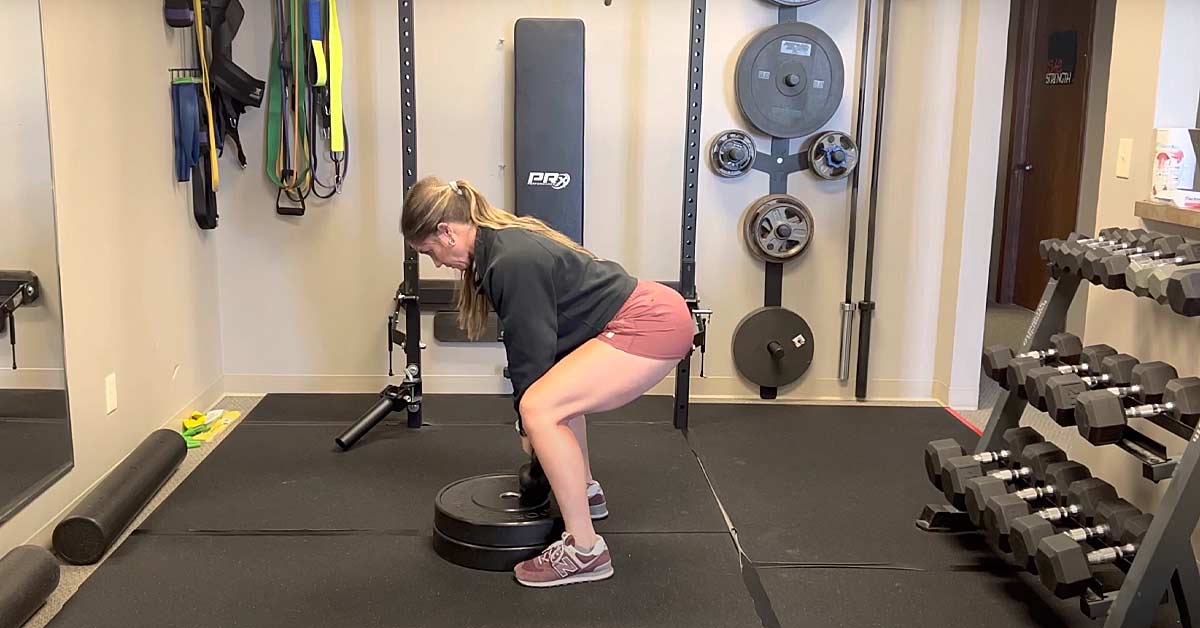Skills will only improve as much as one’s ability to move athletically! A pitcher can spend hours on the mound at camps, work with private pitching coaches, throw in the backyard, compete in games, and pitch in practices to improve her velocity, pitch count, spin, and power. In my experience, however, I’ve realized that many of the girls I work with lack athletic development for basic movements. The less a softball pitcher can move athletically, the less she’ll be able to pitch faster, injury-free, and efficiently.
I ask the girls to work on a few basic athletic movements during our sessions.
- Squat.
- Hinge.
- Jump & land.
- Single-leg foot/ankle stability.
- Pelvis + trunk separation.
I utilize five tests to determine what the fastpitch pitchers I work with lack athletically. From these tests, I begin to implement programming that involves warm-ups, strength movements, lifting, and games that improve overall athleticism and movement—and, as a result (hopefully), the fastpitch pitcher’s skills.
I utilize five key tests to determine what the fastpitch pitchers I work with lack athletically, says @shestrength. Share on XWhen implementing solutions to the tests, we start with the very basic parts of these lifts and progress them over weeks, months, and years.
Test #1: Can You Squat Well?
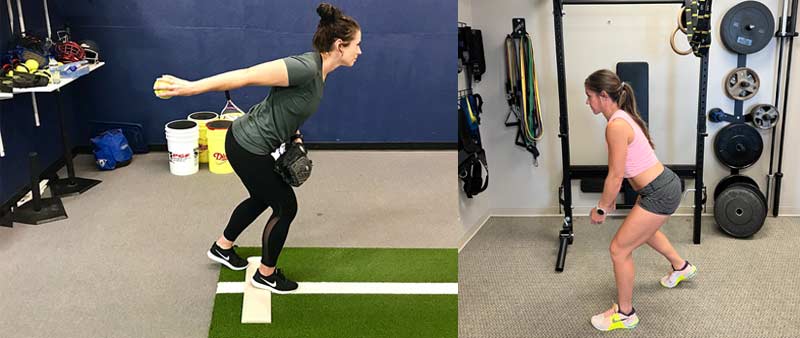
The primary keys I look for are:
- Whole foot on the floor.
- Neutral spine.
- Knees lined up with toes.
- Correct core brace.
- Butt back.
All of those = athletic.
Video 1. Keys to a good squat.
Ways to Improve the Squat
Surprisingly, squatting well is something we have to teach to kids nowadays. The more kids sit, and the less they play, the more I find myself, as their coach, having to teach basic movement patterns. This includes how to squat well.
Common cues I use for squatting are:
- “Sit in a chair.”
- “Hover over a public toilet seat.”
- “Get in the ready position with hands on your knees.”
From there, I have kids sit to stand on a tall box to learn to initiate the proper hip hinge of a squat. Then, we practice isometric squat holds and eventually segue into loaded goblet squats. Next, we quickly move into split stance squat positions with isometric holds.
Video 2. Iso squat hold demo.
Video 3. Iso split squat hold demo.
Test #2: Can You Hinge Well?
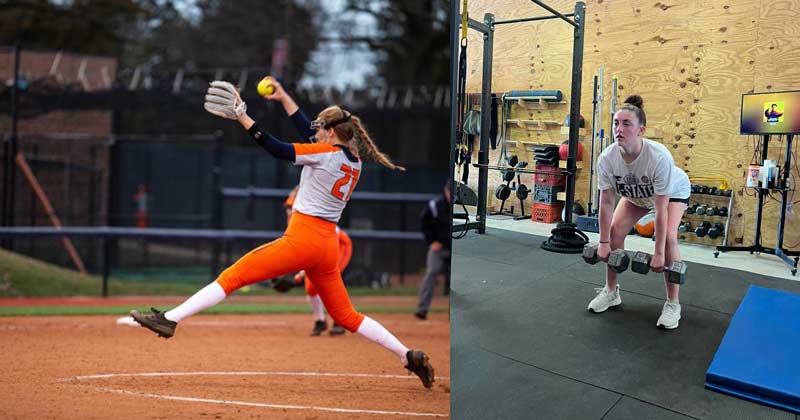
For the hinge, I look for:
- Whole foot on the floor.
- Neutral spine.
- Knees lined up with toes.
- Correct core brace.
- Butt back.
All five = athletic.
Video 4. Hinge athleticism test for pitchers.
Ways to Improve the Hinge
Hinging is a difficult movement for many athletes, especially younger kids. Common cues I use for hinging are:
- “Push the butt back.”
- “Shut the door with the hips.”
- “Pretend you’re hovering over a public toilet seat.”
- “Think of moving your hips forward and back, not up and down.”
For visual/tactile cues, I like using a foam roller or a target that the athlete can reach back toward with the hips.
Video 5. Hinging to a target.
Video 6. Hanging stance with support.
Video 7. Fake ball slams (SLDL).
Video 8. Kettlebell deadlift jump and land.
Test #3: Can You Jump and Land Well?
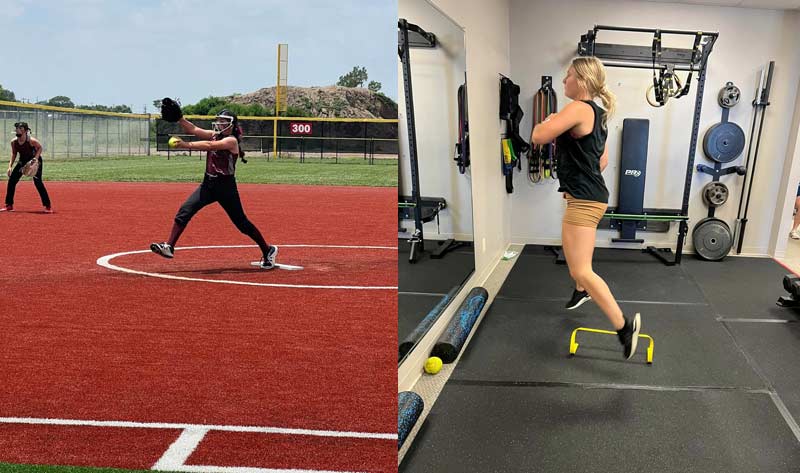
For this test, I visually assess:
- Whole foot on the floor.
- Neutral spine.
- Knees lined up with toes.
- Correct core brace.
- Butt back.
- Squat + hinge to load, then powerfully extend knee, hip, and foot to jump up/out and land.
Those six things = athletic.
Video 9. Jump and land test for softball.
Ways to Improve the Jump + Land
Strong explosiveness off the rubber is key for a high-velocity pitch, but finding a way to land on a firm front-side leg is crucial for arm whip and rotation. Surprisingly, many kids do not know how to use the ground to push off for power and lack the strength/stability to absorb the force of that drive through front-side resistance.
Video 10. Single-leg DL and jump over hurdle.
Video 11. Pitching push-off and land drill.
Test #4: Can You Stabilize a Single-Leg Squat Hold Through Your Foot and Ankle for an Extended Period?
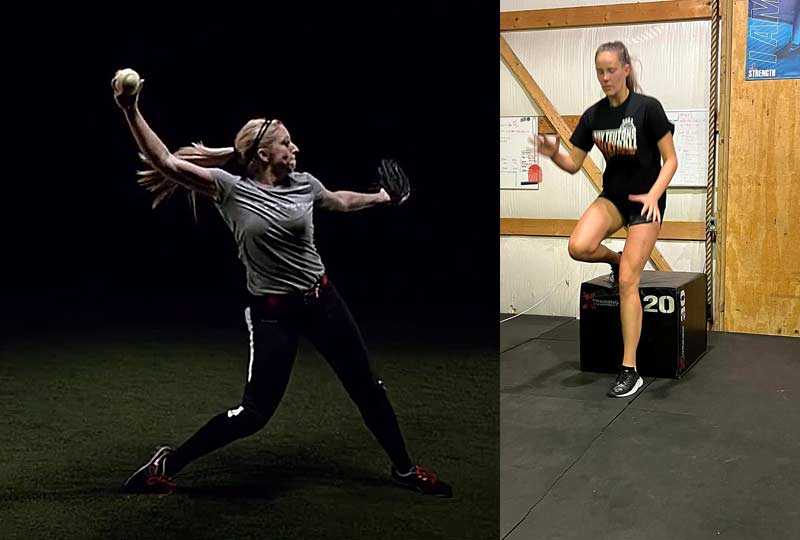
Keys for this quality are:
- Load big ball of foot and little ball of foot, heel lifted.
- Neutral spine.
- Knees lined up with toes.
- Correct core brace.
- Butt back.
- Low heel, high squat hold for 10 seconds.
- High heel, low squat hold for 10 seconds.
Video 12. Spring ankle test.
Ways to Improve Single-Leg Foot/Ankle Stability
An athlete’s ability to produce a ground force reaction from the foot into a powerful leg drive is dependent upon their foot strength. A few of my favorite exercises to help produce a strong foot and ankle connection are shown below.
Video 13. ISO ankle and knee drive into a wall.
Video 14. Ankle ISO hold and drive.
Video 15. Deep lunge ankle stability and hold.
Test #5: Can You Separate the Core from the Pelvis?
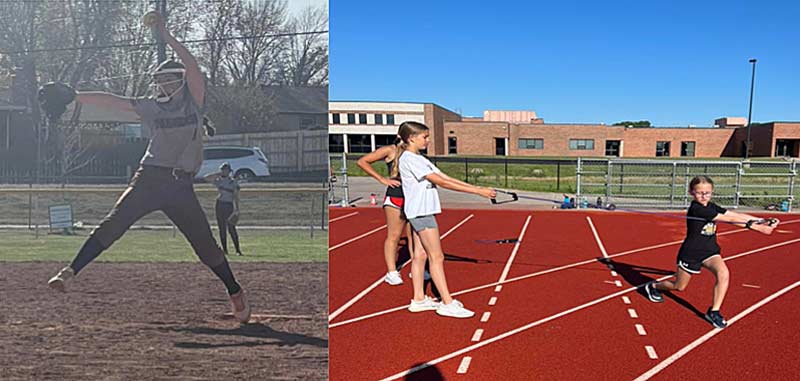
For this last test, I’m observing:
- Whole foot on the floor.
- Neutral spine.
- Knees lined up with toes.
- Correct core brace.
- Butt back.
- Keep the torso straight and rotate the pelvis forward and back like sliding your hips under a plane of glass extending sideways from your hip bones.
Video 16. Rotation test for pitchers.
Ways to Improve Pelvis + Trunk Separation (oblique sling)
The ability of the athlete to keep the pelvis aligned and the core activated through the oblique sling depends on their ability to separate the torso from the hips. The oblique sling activation depends upon foot load, core control, and separation.
Some of my favorite ways to help an athlete learn how to create separation are shown below.
Video 17. Pitching separation ISO holds
Video 18. Plyo + separation drill
Video 19. Front side resistance + rotation
Targeting the Five Qualities in a Session
We work through these steps one by one in each session. We break down how a pitch includes all these movements throughout, including when and where the squat, hinge, jump, land, and rotation occur. Then, we discuss why it’s important to do these basic movement patterns very well—to ensure efficiency, power, and safety are on point, pitch after pitch. Once the athlete can see how a pitch is broken down into these specific movements, we can usually get buy-in to the “less sexy” practice of squat holds, etc.
Session 1: We assess the squat, single-leg squat, and the ability of the athlete to hold this position. Then, we correct any issues and practice getting into a better position. If this goes well, we move into split squat positions and how to hold them well. From here, we work pitching drills from squat and split squat positions.
Session 2: We assess the hinge and get into better hinging positions, both with bilateral and split stances. From here, we work on pitching drills with a newly acquired hinge pattern applied. We also revisit the squatting positions of a pitch we covered in the first session.
Session to session, we continue adding movements to the pitch. Jumping and landing and rotation/anti-rotation seem to be the hardest movements for athletes to learn or relearn. We spend most of our sessions on these patterns.
Jumping and landing and rotation/anti-rotation seem to be the hardest movements for athletes to learn or relearn. We spend most of our sessions on these patterns, says @shestrength. Share on XAs athletes begin to understand and better apply these movements to their pitch, they should notice a smoother and more efficient pitching pattern. A more relaxed arm and less hip/shoulder pain are good signs that the athlete is beginning to use their entire body to throw, not just the arm or front hip, AND is an indicator that the movement patterns and drill breakdowns are working!
**Author’s Note: Many of these thoughts/tests are inspired by other strength coaches and professionals such as Cal Dietz, Chris Korfist, Dynamic Neuromuscular Stability, ALTIS, and other pitching coaches.
Since you’re here…
…we have a small favor to ask. More people are reading SimpliFaster than ever, and each week we bring you compelling content from coaches, sport scientists, and physiotherapists who are devoted to building better athletes. Please take a moment to share the articles on social media, engage the authors with questions and comments below, and link to articles when appropriate if you have a blog or participate on forums of related topics. — SF

